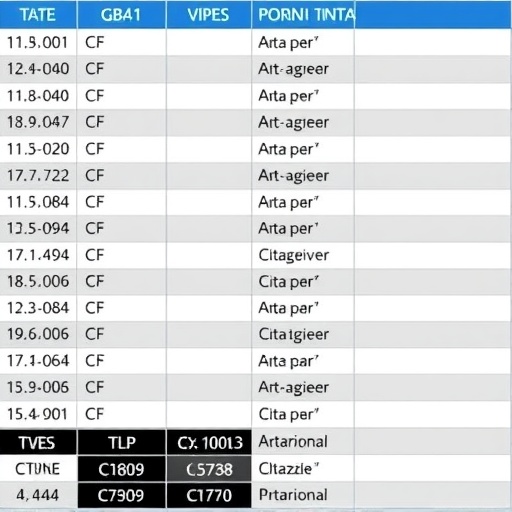The intricate relationship between genetics and neurodegenerative diseases has long intrigued scientists, with Parkinson’s disease (PD) standing at the forefront of this research due to its complex etiology and wide-ranging impact on patients worldwide. A recent development in this domain is a groundbreaking study focusing on the classification of GBA1 gene variants and their impact on Parkinson’s disease, based on advanced computational analyses. This study, conducted by Lanore, Tesson, Basset, and colleagues, represents a significant leap forward in understanding how specific genetic variations influence the progression and manifestation of PD, potentially paving the way for personalized therapeutic strategies.
At the heart of this research lies the GBA1 gene, which encodes the enzyme glucocerebrosidase, a critical player in lysosomal function. Mutations in GBA1 have been increasingly recognized as one of the most common genetic risk factors for Parkinson’s disease, markedly elevating susceptibility and often correlating with earlier onset and more severe phenotypes. The challenge, however, has been the heterogeneity of GBA1 variants, making it difficult to delineate which mutations are truly pathogenic versus benign. To address this, the authors applied sophisticated in silico approaches, leveraging computational algorithms that predict the functional impact of various GBA1 mutations through extensive scoring systems.
Utilizing a robust dataset of known GBA1 variants, the study implemented an integrative scoring framework combining multiple predictive models. This approach evaluated biochemical stability, protein folding dynamics, and lysosomal trafficking efficiency, which are crucial factors in maintaining cellular homeostasis and mitigating neurodegenerative processes. By analyzing these characteristics, researchers identified distinct categories of variants, ranging from benign polymorphisms that pose minimal risk to severely deleterious mutations that significantly compromise glucocerebrosidase function, exacerbating neuropathology.
Central to the methodology was the application of machine learning-driven in silico models, which enable rapid and cost-effective screening of genetic variants without extensive laboratory experimentation. These models not only consider the physicochemical properties of amino acid substitutions but also integrate evolutionary conservation data and structural biology insights. This multilayered strategy enhances the accuracy of pathogenicity predictions, providing invaluable information on how each variant potentially disrupts enzyme functionality and contributes to lysosomal dysfunction—a hallmark of Parkinson’s disease pathogenesis.
The implications of this research extend far beyond the academic sphere, as understanding variant significance is vital for both clinicians and patients. Accurate classification enables precise genetic counseling, risk assessment, and informed decision-making regarding surveillance and prophylactic interventions. Moreover, insights into the functional impact of GBA1 variants foster drug discovery efforts aimed at restoring or compensating for glucocerebrosidase activity deficits, a promising therapeutic avenue for mitigating PD progression.
Remarkably, the study also discusses the role of intermediate variants that do not cause outright loss of enzyme function but potentially modulate disease trajectory through subtle biochemical alterations. These findings challenge the simplistic binary categorization of mutations and underscore the need for nuanced frameworks that recognize a spectrum of pathogenicity, reflecting the complex interplay between genetic background, environmental factors, and molecular mechanisms influencing Parkinson’s disease.
The in silico classification presented by Lanore and colleagues further elucidates genotype-phenotype correlations by integrating clinical datasets with computational predictions. This synergy allows a more comprehensive understanding of how specific GBA1 variants associate with PD severity, motor and non-motor symptoms, and progression rate. Such correlations are instrumental in stratifying patient cohorts for clinical trials, thus enhancing the precision and efficacy of experimental therapies tailored to genetic profiles.
This research not only underscores the utility of bioinformatics in neurogenetics but also highlights the transformative potential of interdisciplinary approaches combining genomics, structural biology, and computational science. The ability to predict variant pathogenicity with high confidence accelerates translational research, ultimately aiming to devise targeted treatments and improve quality of life for individuals affected by Parkinson’s disease.
Additionally, the authors emphasize the importance of continuous refinement of in silico tools through incorporation of novel data from biochemical assays, patient-derived cellular models, and longitudinal clinical observations. This iterative feedback loop between computational predictions and empirical validation is critical for evolving the accuracy and reliability of variant classification systems, ensuring their clinical utility and adaptability to newly discovered mutations.
Emerging from this study is a paradigm shift in PD research methodology—moving from traditional single-variant analyses to comprehensive, integrative scoring that accounts for multifactorial influences on enzyme function. This holistic perspective aligns with the growing recognition that Parkinson’s disease is a heterogeneous disorder requiring equally sophisticated approaches for elucidation and intervention.
Furthermore, the findings have broader implications for understanding other lysosomal storage disorders and neurodegenerative diseases where GBA1 and lysosomal pathways intersect, potentially revealing shared pathogenic mechanisms and therapeutic targets. This cross-disease insight enhances the translational impact of the research, fostering collaborative efforts across neurological and genetic disciplines.
Crucially, this work sets a precedent for future studies aimed at high-throughput variant screening, leveraging artificial intelligence and big data analytics. By harnessing these technological advancements, the scientific community can rapidly expand genetic databases, improving variant interpretation and facilitating large-scale epidemiological studies that capture population-specific mutation profiles and disease risks.
In sum, the comprehensive classification of GBA1 variants integrating in silico scoring techniques represents a milestone in Parkinson’s disease genetics, elucidating the molecular underpinnings of variant-associated risk and opening avenues for personalized medicine. As these findings permeate clinical practice and research, they promise to accelerate the development of genotype-informed interventions that may one day transform the management and prognosis of Parkinson’s disease worldwide.
Such groundbreaking research underscores the essential role of cutting-edge computational biology in decoding the complexity of human diseases. As we stand on the cusp of precision neurology, the integration of genetic insights with innovative technologies heralds a new era in combating Parkinson’s and similar neurodegenerative disorders through tailored therapeutic approaches grounded in individual genetic landscapes.
Subject of Research: Genetic classification and impact of GBA1 gene variants on Parkinson’s disease using computational (in silico) scoring analysis.
Article Title: Author Correction: Classification of GBA1 variants and their impact on Parkinson’s disease: an in silico score analysis.
Article References: Lanore, A., Tesson, C., Basset, A. et al. Author Correction: Classification of GBA1 variants and their impact on Parkinson’s disease: an in silico score analysis. npj Parkinsons Dis. 11, 331 (2025). https://doi.org/10.1038/s41531-025-01204-8
Image Credits: AI Generated
Tags: advanced computational algorithms in geneticsbreakthroughs in Parkinson’s disease classificationcomputational analysis of GBA1 mutationsearly onset Parkinson’s disease correlationsGBA1 gene variants in Parkinson’s diseasegenetic risk factors for neurodegenerative diseasesglucocerebrosidase enzyme functionheterogeneity of GBA1 variantspathogenic versus benign mutations in PDpersonalized therapeutic strategies for Parkinson’s diseasesevere phenotypes in neurodegenerative disorderssignificance of genetic research in PD





